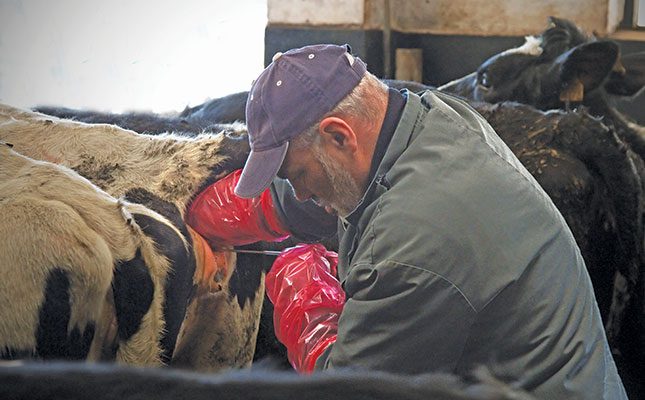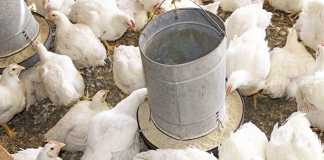
Artificial insemination (AI) of livestock is not a new practice, but an article published by the University of Missouri in June 1939 is probably one of the first to detail the use of AI on the dairy cattle at the university’s experimental farm. According to the article, AI was first used on the farm’s dairy cows in July 1937.
“During the past 18 months, this method of impregnating dairy cows has given such encouraging results that the practice has been adopted by approximately 100 dairy farmers in Missouri. Breeders co-operating with the Department of Dairy Husbandry have supplied records showing nearly 500 cows settled in calf with an average service rate comparing [favourably] with natural service,” the article stated.
According to the article, the practice went back to the late 1700s, and was used in Russia by the Tsar in the early 1900s to impregnate dairy cows on a stud farm. From 1923, the practice had become more widespread in Russia. In 1930, almost 20 000 cows had been impregnated using AI. By 1938, this number had risen to 1,5 million cows, which was around 5% of Russia’s total dairy cow population.
“The Department of Dairy Husbandry, University of Missouri, first used artificial breeding in the spring of 1937 when a valuable proved sire, Campus Aaggie Segis Sultan 586515, sustained a thigh injury which prevented his serving a cow. Semen was obtained by massage and several cows inseminated.”
Since then, AI has become an increasingly important feature of stud and commercial farms. As researchers from the University of Missouri discovered, AI offered several benefits, one of which included the proliferation of the genes of prized animals not otherwise capable of serving cows. As the researchers said in the article: “The usefulness of superior sires may be increased many-fold.”
Other benefits of AI, which are still very relevant today, listed by the researchers also included the fact that smaller breeders, who do not necessarily have the capital to buy top bulls, can obtain top genetics through buying semen straws.
“The danger of spreading genital diseases (such as trichomonads) is [also] materially reduced,” the article explained.
As the technology of AI has improved over the years, other benefits have also become apparent. AI, for example, can prove a bull’s fertility much faster than conventional mating, due to testing now available on the market. The use of disease-free semen can also reduce the spread of reproductive diseases in the herd. AI offers the more efficient use of resources, as fewer bulls need to be kept on the farm. This also means less labour is needed, and reduces the potential occupational hazard in keeping and managing bulls.
In addition, it reduces vet costs and care, as fewer animals need to be kept healthy. Farmers are also able to keep more accurate records of parentage, which is essential for genetic evaluation and selection decisions.
Finally, AI eliminates the risks associated with conventional mating, such as injury to animals.
However, there are some disadvantages to AI. One of the most prominent of these is that specialised knowledge is required for successful AI. While there are many companies that provide AI services, it is essential that farmers still have some knowledge of what AI entails.
Getting started
AI involves placing semen directly into the uterus, and can involve other processes such as embryo flushing and transfer as well. Embryo flushing and transfer involves the transferring of fertilised ova from a donor female to a recipient female, who then rears the calf.
Embryo flushing allows for female animals to expand their genetic reach through the use of surrogate female animals. (The donor female animal does not carry the embryo to term, allowing her to produce many more calves than would have been possible if she had to gestate the foetus to term.) AI is used in commercial and stud herds.
Jordan Thomas, assistant professor of Animal Sciences, and Carson Andersen, a graduate research assistant in the Department of Animal Sciences, both at the University of Missouri Extension, say that careful preparation is essential for successful AI.
“Using the correct techniques when performing AI can help ensure success while minimising risk of injury to the technician and the animal. Becoming proficient at performing AI takes adequate training, knowledge, and repetition. Successful AI requires skilfully depositing the semen in the proper location in the female reproductive tract while using sanitary techniques,” they write in an article entitled ‘Artificial insemination of cattle: Step by step’.
Thomas and Andersen say the day before AI, farmers need to make sure all equipment and supplies are sanitised and ready for use. “Contaminants such as dirt and manure can be damaging to sperm, [and can introduce] infectious bacteria into the reproductive tract [of the cow].”
For the technician or farmer performing the procedure, all jewellery, such as watches or bracelets, must be removed, as they can cause injury to the cow. When performing AI, both hands are in use: the non-palpating arm, and the arm that manipulates the AI catheter. Thomas and Andersen recommend placing a shoulder-length sleeve on the palpating arm.
“Most technicians choose to palpate with their non-dominant hand while manipulating the AI catheter with their dominant hand. In addition, some technicians prefer to use an additional latex or nitrile glove on the outside of the sleeve to improve fingertip dexterity.
“Apply non-spermicidal lubricant to the palpating hand.”
Thomas and Andersen emphasise that it is essential to keep the tip of the AI catheter as clean as possible to reduce the risk of introducing bacteria into the uterus.
“After loading the straw into the catheter, keep the loaded AI catheter warm and protected, either using an AI catheter warmer or tucking it into your shirt until it is time to AI. Although completely sterile technique is not necessary or possible, care should be taken to keep the sheath of the loaded catheter clean.”
When ready, the technician should point his or her fingers and thumb together and gently insert the palpating hand into the cow’s rectum.
“With [the] free hand, use a paper towel to wipe the vulva free of any manure in order to avoid bringing in infectious bacteria.” Once inserted, make a fist and apply downward pressure.
Thomas and Andersen say this will cause the vulva to open slightly, allowing for an easier entrance into the vagina.
“Insert the AI catheter into the vulva at a slight upward 30° angle to avoid inserting the catheter into the urethra and into the bladder,” Thomas and Andersen explain. “If you believe you have inserted into the urethra, pull the catheter back while not completely removing the tip of the catheter from the vagina.
“It is important to not remove the catheter once you have inserted it in order to prevent contamination of the tip upon removal. Begin to level out the angle of the catheter as you gently push the catheter forward into the reproductive tract.”
Thomas and Andersen emphasise that pushing the catheter into the reproductive tract must be done slowly and gently. “It does not take much force to move the AI catheter through the reproductive tract. Avoid applying too much forward pressure with the catheter, as this should be unnecessary and could cause irritation or injury.
“Vaginal folds will often cause resistance and prevent the catheter from proceeding easily into the tract. If you believe the catheter is stuck in a vaginal fold, manipulate the reproductive tract with your palpating hand while readjusting the direction of the catheter.”
The cervix
The cervix is the opening of the uterus, and it is here that the process may become a little more difficult. Thomas and Andersen explain that the technician needs to palpate the reproductive tract to find the cervix.
“Cervices will vary in size and shape, but all will have the dense feel of connective tissue, distinct from the feel of the vagina or uterus. The cervix is often described as feeling like a ‘turkey neck’. Keep in mind that heifers will have smaller cervices than mature cows.”
Once located, the tip of the catheter should be moved to the opening of the cervix.
“The catheter may already be in contact with the cervix. If not, take a firm hold of the cervix and push it forward. This straightens out the reproductive tract and eliminates folds in which the catheter may be caught. Gently readjust the depth and direction of the catheter until you can easily guide it to the opening of the cervix.”
Once the AI catheter has been brought closer to the cervix, Thomas and Andersen say the next step is to insert the tip of the catheter into the cervix. They add that this is one of the more challenging steps of AI.
“Around the cervix, the vagina forms a blind-ended pocket called the fornix vagina. It is common for the tip of the catheter to be in the fornix rather than in the opening of the cervix.
“In addition, the fornix tends to stretch, making the catheter appear to be advancing forward when it could really be above, below or to the side of the cervix. If you feel you are trapped in the fornix, pull the catheter back slightly and use your palpating hand to clamp down around the vaginal end of the cervix.
“This closes off the fornix and allows your palm and fingers to guide the catheter straight to the opening of the cervix. Due to the cervix being made of dense tissue and cartilage, you will feel a ‘dragging’ sensation to the catheter once the tip is at the opening of the cervix.”
Thomas and Andersen add that if the cervix is far over the pelvic rim or hard to grip, the technician should pull the cervix towards him or her after the catheter is near the opening of the cervix.
“You can also press the cervix against the rim of the pelvis to create more support. Once the AI catheter is in the cervix, you will need to pass the catheter through the annular rings. Most cows and heifers will have three to four annular rings. Passing the catheter through the rings can be very challenging in some animals, as the cervix is a tough structure and may require a lot of manipulation.
“A key concept is to work the cervix back onto the catheter using your palpating hand, rather than pushing the catheter. After passing through one ring, maintain light forward pressure on the catheter while you turn and angle the cervix to find the opening to the next ring.”
Thomas and Andersen again caution extreme care, as uterine tissue is very thin and can be easily punctured by the catheter if too much force is applied.
Depositing semen
Thomas and Andersen explain that depositing semen in the correct place is critical for AI success. They say semen should only be deposited in the uterine body, and explain that if semen is deposited in the cervix instead of in the uterus, the majority of the sperm cells will flow back into the vagina rather than the uterus. This will lead to a lower success rate.
“To ensure that the AI catheter is in the correct place for depositing the semen, feel for the tip of the catheter with your fingers. If the catheter is still in the cervix, you will not be able to feel the tip of the catheter very well since the cervix is a dense structure. However, if the catheter is through the cervix and in the body of the uterus, you will be able to feel the tip of the catheter through the thin walls of the uterus [with your palpating hand].
“You want to clearly feel about a half inch to an inch of catheter in the body of the uterus. It is critical to avoid pushing the catheter farther into the uterus and down a uterine horn. Be gentle with movement of the catheter once through the cervix, as the uterine lining is very thin and prone to irritation.
“Once you are confident the tip of the catheter is in the correct location, deposit the semen. This should be done by depositing the semen relatively slowly (three to five seconds). In addition, keep the catheter in the same place while depositing semen, making sure not to pull back into the cervix until the semen has been deposited.”
In conclusion, Thomas and Andersen say that successful AI requires practice and the correct skill set. They advise farmers to attend AI courses before attempting the procedure on their animals.
Sources: https://extension.missouri.edu/; core.ac.uk













